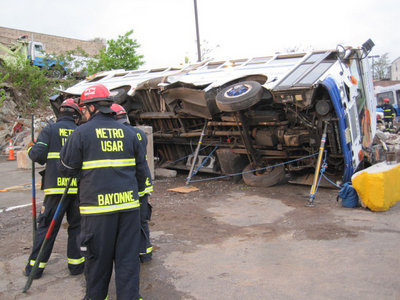Even when the disaster is simulated, it scares the hell out of you.
Bayonne Fire Chief Greg Rogers arrived on the scene of this year’s simulated disaster in time for the extraction of victims from a collapsed parking deck.
“It was eerie,” he said, knowing deep down in his bones that it could become real in an instant, just as it had on that bright Tuesday morning back in 2001 when people went to work at the World Trade Center, only to find the world falling on in their shoulders.
But Urban Areas Security Initiative (UASI) drills have roots that go back farther than Sept. 11, 2001. The federal government knew as early as the mid-1990s that monumental disasters could strike anywhere and any time, and that the country was ill-prepared to deal with them.
Disasters elsewhere in the world – especially the threat of terrorism – told officials that they needed to gear up and be ready for something big which might occur here in the United States.
In 1997, Congress passed the United States Domestic Preparedness Program, which set up drills designed to improve emergency response times and provide practice for communicating with first responders for quick and safe patient evacuation techniques. Simulated communication drills in Hudson County were scheduled for the very week on which the attacks occurred on Sept. 11, 2001, and, in fact, the Port Authority had planned to a full scale emergency test in early 2002 simulating an attack on the World Trade Center.
9/11 accelerated need for preparedness
“Many of the changes made to how departments handle disasters came after the hard lesson on 9/11,” said Bayonne Public Safety Director Jason O’Donnell. “We need great interoperability in order to accesses other resources.”
In other words, agencies that do not normally work together side-by-side had to come together in case a large disaster required more resources than any municipality could provide.
What if disaster struck in one of the more crowded venues in area – not a mall, but the newly constructed sports facility in Harrison? Would firefighters be able to work together in order to rescue injured people and minimize the impacts?
That was the scenario that firefighters from six counties had to deal with in this year’s disaster drills at the MetroStars Stadium.
Rogers said Bayonne has been involved with training exercises under the Urban Areas Security Initiative for at least five for six years, and this year, they were among the area fire departments that became what was called “The Metro USAR Strike Team,” which participated in a four-day disaster training exercise in late April.
Bayonne firefighters worked side-by-side with firefighters from the Newark Fire Department, Paterson Fire Department, Hoboken Fire Department, Hackensack Fire Department, North Hudson Fire, Elizabeth Fire Department, Jersey City Fire Department, Morristown Fire Department, Middlesex County Fire and Port Authority Police to deal with a variety of scenarios that tested use of new and sophisticated equipment in search and rescue operations.
“Many of the changes made to how departments handle disasters came after the hard lesson on 9/11.” – Bayonne Public Safety Director Jason O’Donnell
__________
Members also include New Jersey Transit and Port Authority of New York and New Jersey police officers. The team’s full complement counted approximately 500 members.
Hosted at the Newark Fire Department training grounds, emergency workers gathered to practice and respond to multiple emergency props designed to test and perfect the special operations skills of area Metro Strike Teams.
The Bayonne Fire Department is equipped with a specialized rescue rig and tools issued through UASI funds, and the firefighters receive technical training to deal with high-level rescues. Over a period of four days, firefighters practiced rescuing entrapped victims from beneath concrete and crushed vehicles at a mock multistory parking garage collapse. Numerous rescue scenarios took place simultaneously and involved multiple agencies unified in their efforts.
Fabricated tunnels of collapsed concrete and steel served as props that entombed trapped victims making for difficult and challenging rescues. The firefighters worked for hours perfecting techniques and skills relevant to collapse and infrastructure.
Operated regionally with oversight from the state Office of Homeland Security and Preparedness, the UASI program is federally funded by the U.S. Department of Homeland Security and designed to help protect the country’s urban areas most prone to potential terrorist attack.
“Bayonne firefighters train routinely for technical rescue operations, and the federal funds that are used to sustain hands-on training and drills ensure that our response personnel are prepared,” Rogers said. “The UASI drills are as realistic as they could be, and simulate a myriad of potential life threatening incidents. We are reminded by the anniversary of the death of [Osama] Bin Laden that we must maintain a vigilant presence.”
